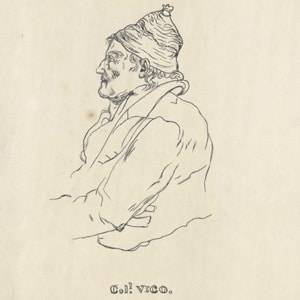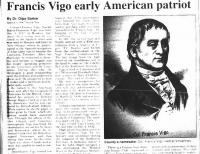
December 13, 1747 - Francis Vigo (Dec 13, 1747 — Mar 22, 1836)
Colonel Francis Vigo (Joseph Maria Francesco Vigo) was born Dec. 3, 1747, at Mondovi, Sardinia. As a young man he enlisted in the Spanish army and was sent to Havana and later to New Orleans where he participated in the Spanish occupation of what later was to become the Louisiana Territory. After his discharge, he remained in America and became a trapper and fur trader, operating primarily in the Vincennes and St. Louis areas. During this time, he developed a good relationship with the Indians and understood them well. He prospered as both a trader and a merchant and became quite wealthy.
He rallied to the American cause and, after the recapture of Vincennes by the British, volunteered his services to General George Rogers Clark as a spy for the Americans, but he was captured by British-allied Indians. While captive he ate the paper (a letter given by Clark) which otherwise would have convicted him. Through the efforts of Father Gibault and Vincennes townspeople, Vigo was freed. He immediately set out for St. Louis and Kaskaskia, where he informed Clark that the British occupied Vincennes and how strong they were. At this time, Clark was short of funds and almost was unable to lead a campaign.
Immediately Vigo loaned him $11,000, which led to a successful campaign and freedom. But Vigo never was repaid in his lifetime. In his last will he made a request that if the government ever honored his claim, then $500 from his estate should be used to purchase a bell inscribed “presented by Francis Vigo” for hanging in the Vigo County Courthouse.
In 1887 the six foot high bell finally arrived with a $500 contribution from a relative of Vigo’s (T. C. Buntin) and $2,500 from the authorization of the Vigo County Commissioners. The bell hangs from the high tower of the courthouse and is declared by some as “the Liberty Bell of the Northwest territory.”
Vigo settled in Vincennes and in 1793 married Elizabeth Shannon, a sister of “Alice of Old Vincennes.” They had no children.He was a prosperous fur trader and at one time became very rich, but unfortunately at the time of his death he was a poor man. He died in Vincennes on March 22, 1836, and was buried in the City Cemetery in Vincennes.
Indiana legislature conferred upon the county the name of Vigo (to be pronounced “vee-go”) in honor of Colonel Vigo, then a resident of Vincennes. The name was approved Jan. 21, 1918.
Vigo visited Vigo County for the last time on July 4, 1832.

High praise has been given to Colonel Francis Vigo for his bravery and assistance during the conquest of the Northwest Territory. A memorial statue of him by John Angel occupies a site overlooking the Wabash River in the Vincennes Memorial to George Rogers Clark.
A commemorative stamp and postcard were issued in honor of Francis Vigo on May 24, 1986.
There is a Francis Vigo American-Italian Club (organized in 1972) in Vigo County whose purpose is to help its members to have an appreciation of their heritage as descendants of immigrants and an awareness of their customs and culture. This club has contributed funds to replenish a room in honor of Francis Vigo in the Vigo County Historical Museum.
